Chevrolet Bel Air Reviews
You'll find all our Chevrolet Bel Air reviews right here. Chevrolet Bel Air prices range from $7,260 for the Bel Air to $10,010 for the Bel Air .
Our reviews offer detailed analysis of the 's features, design, practicality, fuel consumption, engine and transmission, safety, ownership and what it's like to drive.
The most recent reviews sit up the top of the page, but if you're looking for an older model year or shopping for a used car, scroll down to find Chevrolet dating back as far as 1960.
Or, if you just want to read the latest news about the Chevrolet Bel Air, you'll find it all here.
Chevrolet Reviews and News

Car makers must show drive
Read the article
By MP Kim Carr · 24 Jan 2012
JIM Griffin's company makes car hinges and tie-down cleats in Reservoir. He sells them in China - despite a 67 per cent increase in the value of the dollar from the lows we saw in 2008.The car industry is one of our top export earners. The all-American Chevrolet Camaro was engineered in Melbourne - and so was the new Ford T6 Ranger pickup truck, sold in more countries than any other Ford vehicle.The car industry put this city on the global innovation map. In the last year on record, the auto industry was the single biggest customer for local tooling.It consumed $1.3 billion in locally manufactured iron and steel, $444 million in polymer products and $157 million in chemicals; along with $1.6 billion of professional, scientific and technical services. The car industry keeps more than 200,000 Australians in work. So imagine this country without it.It's not just the future of the Bathurst 1000 at stake. It's not just your right to drive a world-class Australian car - a right that we've enjoyed for more than six decades and that we still prize today. No less than four of the Top 10 selling cars in this country are locally made.No, take away the cars, and you take away any claims we have on the 21st century. Opinions will differ on the returns we can expect from the resources boom.But no one, however bullish, claims we can rely on it forever. It has pushed the dollar to levels that are crippling to trade-exposed industries - our automakers among them. They are still keeping alive the raw materials of our post-boom economy.The practical know-how. The advanced machinery. The university research programs. These are the bread-and-butter of any auto operation; but they generate jobs and opportunities in countless other ways.Take SMR Automotive, a company making rear-vision mirrors in Adelaide. They supply almost a third of the global market today. But because they know car mirrors, they also know high-precision medical devices. They know how to make whitegoods and lighting systems that cost less to run. They have the skills in optical engineering, in high-precision moulding and in polymer electronics to take the lead in all these fields.Companies like SMR are first and foremost automakers. They look to the three major vehicle producers in this country - Ford, GM Holden and Toyota - to provide the work that keeps people on the job, day in, day out. Those producers provide vital links to the global auto industry, still the great powerhouse of modern industrial progress.That's how Australians stay at the peak of the technology curve; and that's how our component makers break into the global production chains.I have little patience with commentators who insist on seeing this country as some kind of automotive backwater. Australia is one of only 13 nations with all the capabilities to take a car from the drawing board to the dealership - and we have sustained that position at a far lower per capita cost than most.Every Australian claims the benefits of the auto sector for less than $18 each. Every American is paying 14 times that sum. So this is not the moment to be slashing our support, as Mr Abbott would have us do. It is time to prove to the world that this country is ready to make cars for the 21st century.Electric cars are part of that future. But so too are lightweight composite parts. So are alternative fuels. So are intelligent design and clean manufacturing technology.Australia can undoubtedly compete on its strengths in these fields - which is why innovation has always been the heart and soul of our $5.4 billion New Car Plan for a Greener Future.That's how we secured the low-emission Holden Cruze, the hybrid Toyota Camry, the EcoBoost Falcon. That's how Australia produced the world's first carbon-fibre car wheel, as strong as steel and half the weight.That's why engineers, doctoral students and elite researchers are working together on a large proof-of-concept fully electric vehicle in Melbourne. That's how our auto envoys helped local firms win overseas contracts worth more than half a billion in the last financial year.I am not in the business of holding out false hope. There is undoubtedly a tough fight ahead for this industry, as the hard news from Toyota confirms. But let there be no mistake. This is a battle we are ready to fight.
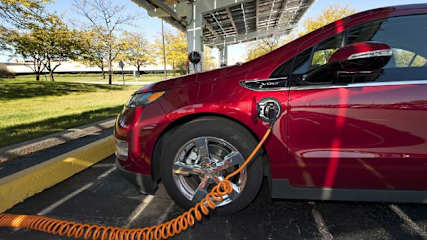
Holden's coming Volt clears fire check
Read the article
By Mark Hinchliffe · 24 Jan 2012
The Volt - which will be Australia's first electric car with a back-up petrol engine to charge the battery - has been cleared of fire danger in the US. The American National Highway Traffic Safety Administration launched an investigation into the Chevrolet Volt, to be sold here later this year as a Holden, after three caught fire several days following crash tests. It has now closed its investigations after GM made engineering modifications to better protect the battery. GM Holden spokesperson Kate Lonsdale says the closing of the investigation clears the way for the Volt in Australia. "Based on the available data, NHTSA does not believe that the Volt or other electric vehicles pose a greater risk of fire than gasoline-powered vehicles," she says. She says it is too early to announce pricing for the vehicle.
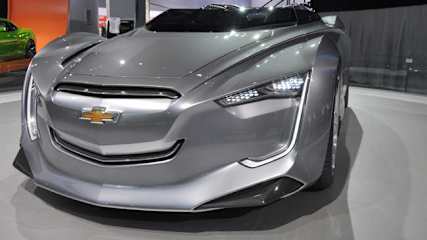
Chevrolet Miray a great concept
Read the article
By Craig Duff · 10 Jan 2012
The Koreans starred, the Japanese mounted a comeback, and One Ford hit the headlines with an extended family of Focus-based newcomers that it is certain to make a big hit in Australia. But it was one car and the commitment of its company chief that made the most impact as America fought back on the opening day of the 2011 North American International Motor Show.But it didn't earn the centre-stage billing of the new twins launched in MoTown, the Tru 140S and the Code 130R. It didn't have to - the Miray already has the runs on the board. It was judged the best concept car at last year's Seoul Motor Show and earned its own pedastal this week at the front of the company's display area. Just like many cars in the Chevy range, there's enough Australian DNA in the mini roadster to justify calling it our own. The Miray was a rush job built last year to celebrate the launch of the Chevrolet brand in South Korea. It's inception was overseen by Andrew Smith, a former Holden design guru who is now managing director of the Seoul-based GM Advanced Design Centre. He called on the talents of Sharon Gauci, Holden's chief colour and trim designer, to help sculpt the interior of the hi-tech vehicle. The all-wheel drive Miray beat the other small car concept duo in using GM's 1.4-litre turbo engine and, while it's loosely based on a Cruze drivetrain, it has also adopted elements of the Volt, using a pair of 15kW motors to power the front wheels. Throw in a carbon fibre body and passenger tub and it's a lightweight rocket with enough Down Under influence to whack an Ettamoggah Pub sticker on the back window (if it had one) and humble the Commodores brigade on a Saturday night blockies cruise. Gauci was involved in turning the Seoul sketches into fabrics and textures and says much of the work was done using Italian suppliers because of their specialised knowledge of low volume, high-end vehicles. The cockpit displays are projected through the dash fabric and Gauci says finding the fabric and ensuring it was applied perfectly straight throughout the curved cockpit was a major project in itself. Then there's the Chevy grille graphic that is heat-embossed on the door fabric and the wrapround dash that extends along the door panels and into the seats themselves. "It was pretty intense. A lot of the time we had to make decisions on the spot (due to the tight project deadline) but I'm really pleased with the way it looks on the stand," she says. Smith cites the inbuilt camera that can record a lap at a track and then ghost it back over on the next lap using the heads-up display in the windscreen as one of the car's coolest features. "There are a lot of elements on the car that we drew on from the Chevy heritage," he says. "I actually took the designers to the GM museum so they could see how some of the classic muscle car elements worked and they've then interpreted that into a futuristic small car." Smith agrees the Holden influence is pervading the GM world and says even the talent still in Australia is having a huge impact on global product. "There's a lot of work done (at Holden) that Australians don't get to see, because it's for the Asia-Pacific market ... but that's not to say GM doesn't recognise the talent they have there," he says.

Chevrolet Camaro Hot Wheels concept
Read the article
By Neil Dowling · 10 Jan 2012
The Koreans starred, the Japanese mounted a comeback, and One Ford hit the headlines with an extended family of Focus-based newcomers that it is certain to make a big hit in Australia. But it was one car and the commitment of its company chief that made the most impact as America fought back on the opening day of the 2011 North American International Motor Show.Chevrolet makes toys for grown ups who believe they can act like kids, so the combination should produce an enthusiast's dream car.Chevrolet and Hot Wheels have created a life-size concept that revisits the motor show circus in Detroit this week after its first showing at last year's debut at the SEMA show in Las Vegas.The Camaro Hot Wheels concept is inspired by Hot Wheels' Custom Camaro, the finger-sized Spectraflame 1:64-scale toy that was part of the original 16 Hot Wheels cars released in 1968. The project was a collaborative effort between the General Motors Design studio in Michigan and the Hot Wheels Design studio in California. Each sketched its own ideas of a life-size Hot Wheels Camaro, compared notes and refined their visions until the concept hit the right note for each group of designers."The Camaro has been a mainstay in the Hot Wheels lineup since 1968,'' says Phil Zak, GM design director. "Several generations of car enthusiasts grews up playing with Hot Wheels Camaros, while dreaming of driving the real thing, so this was a once-in-a-lifetime opportunity to make that dream a reality.''There was a similar buzz of excitement in the Hot Wheels studio."The Hot Wheels and Camaro brands have been paired together since their inception,'' said Felix Holst, vice president of design for the Mattel Wheels Division."As part of the brand's historic sweet 16, the Camaro was the first Hot Wheels car ever produced. The Spectraflame paint and redline tires of those first Hot Wheels cars have been the dreams of guys for generations, and it was thrilling to inject these elements into a Camaro for real.''The full-size result creates a car that is instantly identifiable as a Camaro with styling cues - including flat-black graphics, red-line wheels and the metallic green paint - that are classic Hot Wheels.The original Hot Wheels cars debuted with their metallic Spectraflame paint finishes, and the Camaro Hot Wheels Concept features a chrome-style finish created in a similar manner - that is, a tinted top coat over a shiny base.The reflective finish was created using Gold Touch Inc's Cosmichrome product, starting with the application of a primer coat on an immaculately prepared surface. The primer coat was then sprayed with a liquid-metal solution to create the mirror-smooth, silver-chrome base coat. Then the green tint was applied in several layers until the right colour effect was achieved."It may sound pretty straightforward, but no one had ever tried using this process to paint a whole car,'' says Zak."The bodywork and paint team experimented with several processes before spraying the first body panel. There were so many variables that contributed to getting the finish perfect, from the drying time to the air pressure of the spray guns - none of which was known before this project - and the team absolutely nailed it perfectly."Additional features of the Camaro Hot Wheels Concept include:Over Chrome Green paint with ghosted Hot Wheels logo on the quarter panelsSatin black ground effects (splitter, rocker and rear fascia-side extensions)Satin black wheels with milled face and Torch Red stripe: 20x10-inch (front) and 20x11-inch (rear)ZL1 grille with Hot Wheels badgingHot Wheels badge on the decklidEuro-style taillamps with new inner smoked lensEuro-style rear fascia with new diffuser and exhaust bezelsZL1 rear spoilerChevrolet Accessories Modified Satin Black StripeBlack aluminum CAMARO fender badges with milled faceBlack aluminum hood insert with milled hood vent extractorsChevrolet Accessories Synergy Series gill decalsBlack leather-wrapped IP and door inserts with Torch Red accents, and cut-and-sew flamesHot Wheels sill platesHot Wheels cut-and-sew embroidered logos in the front seatbacksChevrolet Accessories pedal kitChevrolet Accessories footwell and cup holder lighting (red)Brembo brakes: six-piston front with two-piece rotors and four-piston calipers (Chevrolet Official Licensed Product)Suspension lowering kit by Pedders (Chevrolet Official Licensed Product)Chevrolet Accessories strut tower braceChevrolet Accessories black engine coverChevrolet Accessories exhaust system.Under the hood is the all-aluminum 6.2-litre LS3 V8 backed by the Tremec TR6060 six-speed manual transmission.Hot Wheels is making a collectors edition 1:64-scale model based on the full-size concept.It will be the 18th 1:64-scale Hot Wheels Camaro model produced since 1968, all with a variety of colours and configurations. During the past 44 years, literally millions of Hot Wheels Camaro models have been produced.The original Custom Camaro from 1968 remains one of the most valuable Hot Wheels toys among collectors. That year, Hot Wheels produced all the Custom Camaro models with Spectraflame paint - except for one version in white enamel.Today, examples of the Spectraflame Custom Camaro in excellent condition can sell for $150 or more. Only 15 white enamel versions are known to exist, and none are in their original packages.The value of a white enamel Custom Camaro is upwards of $3000, says Holst. But if one still existed in the package, the value could be tens of thousands of dollars.
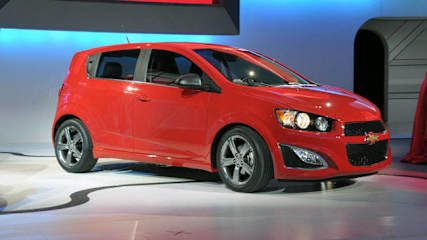
Chevrolet Sonic RS may come here
Read the article
By Mark Hinchliffe · 10 Jan 2012
The Koreans starred, the Japanese mounted a comeback, and One Ford hit the headlines with an extended family of Focus-based newcomers that it is certain to make a big hit in Australia.
But it was one car and the commitment of its company chief that made the most impact as America fought back on the opening day of the 2011 North American International Motor Show.
Chevrolet launched the Sonic RS at the Detroit motor show and Holden boss Mike Devereux likes what he sees.
"It wouldn't be a bad idea," he says about the turbo Sonic -- which is the US name for the Barina. "We would be dumb not to look at it."
The Sonic RS has a 1.4L turbo engine with 102kW of power, fog lamps, 17-inch wheels, sport exhaust, four-wheel discs, lower and stiffer suspension, a sporty flat-bottomed steering wheel and aluminium pedals.
The Chevrolet stand also featured an electric Spark bound for the US next year.
Devereux was guarded about introducing it to Australia.
"We will see how we go with the Volt first," he says referring to the hybrid Volt which is driven by an electric motor with a small petrol engine to charge the battery and increase range.
It is due in Australia later this year and follows some controversy in the US where it burst into flames several days after being crash tested.
Devereux says the issue has recently been resolved with "a bit of steel added to the coolant area". He says the battery also needs to be "de-powered" after a crash.
Futuristic concept cars aimed at the youth market could also make their way to the Australian International Motor Show.
The Tru 140S and Code 130R show cars were produced to gain feedback from young motorists and will displayed at automotive shows around the world.
Devereux did not rule out bringing them to Australia.
The rear-wheel-drive Code 130R even looks like the Aussies Race Cars which are scaled-down versions of V8 Supercars.
Former Holden boss and now GM president of North America, Mark Reuss, says the show cars are part of a "new family of small and compact cars" aimed at the youth market.
Chevrolet senior manager of global marketing, John McFarland, says the challenging youth market represents 40 per cent of potential car buyers.
However, he points out that they have grown up in a digital age, can barely remember life before Facebook and 54 per cent would rather be on a social network than driving.
"They are disinterested in car brands," he says. "A car is like an ugly boyfriend; as soon as something better comes along it's out the door," he says.
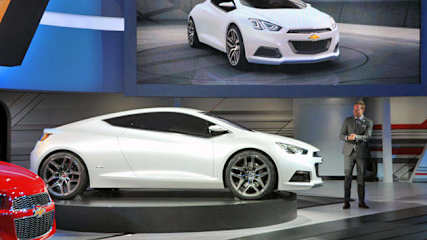
Chevrolet Tru 140S
Read the article
By Craig Duff · 10 Jan 2012
The Koreans starred, the Japanese mounted a comeback, and One Ford hit the headlines with an extended family of Focus-based newcomers that it is certain to make a big hit in Australia. But it was one car and the commitment of its company chief that made the most impact as America fought back on the opening day of the 2011 North American International Motor Show.
Along with the Code 130R Concept, it makes a pair of four-seater performance coupes designed after talking to more than 9000 of the Gen Z audience.
The next-gen customers wanted a range of features, highlighted by a coupe body style that takes four people so their friends can come along for the ride. Performance and fuel economy were other major factors, along with the ever-present need for connectivity. Price was the final determinant, with the cash-conscious demographic wanting to be able to afford it and citing a low-$20,000 starting price.
"Young customers tell us they want functionality with coupe-like aesthetics. Both the Code and Tru body styles resonated with this audience," GM North America Advanced Design studio director Frank Saucedo says.
"This buyer prizes connectivity. Allowing them to stay connected by integrating their personal devices through MyLink and WiFi enables the vehicle to be their own docking station."
The Code 130R is a four-seat rear-wheel drive coupe that pays more than a little homage to classic Chevrolets from pervious eras.
Chevy now plans to take the concepts to the next step by developing interiors based on responses the public provides as the vehicles are showcased at various events - starting with this week's Detroit Motor Show - and on feedback from social media sites.
The engine is a 1.4-litre turbocharged petrol unit taken from the Cruze and fitted with idle stop/start, regenerative braking to improve fuel economy. The front-wheel drive Tru 140S is presented as an "affordable exotic" four-seat coupe.
Chevy says the three-door hatchback was designed to be an attractive-yet-affordable sports car and looks "confident, exotic, expensive and fast". The concept car is based off the same platform as the Chevrolet Cruze and the groundbreaking Chevrolet Volt electric vehicle with extended range.
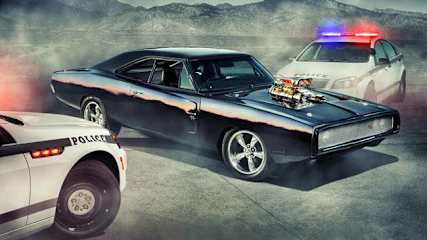
It's a fair cop for Caprice
Read the article
By CarsGuide team · 06 Jan 2012
Is it a cheeky reference to the abilities of our homegrown Holden? Yes, that’s a Dodge Charger – specifically the R/T from Fast and Furious – starring in the middle of this wallpaper image by Douglas Sonders.But flanking it are the Holden (Chevrolet) Caprice Police Pursuit Vehicles that rounded up the Dodge Charger (and Ford's ageing Crown Victoria) in a series of tests by US law enforcement.The Caprice PPV is powered by V8 and V6 engines, though the V8s -- rated at 265kW and 521Nm -- were the ones tested in the Michigan Police Vehicle Evaluation trials and it was the ethanol-boosted E85 version that performed best, smashing its US-built rivals in every aspect from acceleration to braking and outright lap times.It gave the Commodore-based long-wheelbase car the early lead in the sales battle for a market that takes around 70,000 vehicles a year. Holden builds the Caprice PPV in Australia, with department-specific equipment requested by each police force fitted in the US.Holden and its parent company GM have invested considerable time and money to customise the Caprice PPV - and an unmarked police equivalent - for the US law-enforcement market.The front seats have been specially designed to sculpt around police equipment belts, including the gun, Taser and handcuffs. Trial units were fitted to vehicles for police to evaluate and the resulting shape, foam densities and hard-wearing fabric covers is a result of feedback from police on patrol.The electronics - from stability control to ABS - have also been adapted for police use and the side curtain airbags don't prevent a full-width rear security screen from being fitted.CHEVROLET CAPRICE PPVPrice: $30,995Engine: 6-0-litre V8Power: 265kW at 5300 revsTorque: 521Nm at 4300 revsTransmission: Six-speed automatic, rear-wheel driveSeats: FiveSuspensions: MacPherson strut front, independent spring-over-shocks rearBrakes: 345x30mm ventilated fronts; 342x22mm solid rears.
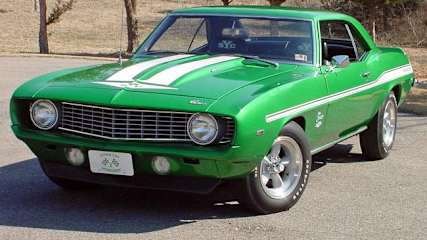
Camaro crowned king
Read the article
By CarsGuide team · 17 Dec 2011
GM's Chevrolet brand is celebrating its 100th anniversary, and as part of its celebrations it asked drivers to vote for the best Chevy of all time?
The answer was the 1969 Camaro. The Camaro edged out such famous models as the 1953 Corvette, the 1957 Bel Air and even the 1963 Corvette Sting Ray - to name a few.
By 1969 the Camaro was extremely popular and though this was the final year of the Camaro's original iconic design, it went out with flying colors.
The `69 Camaro paced the Indianapolis 500 for the second time. It was the first and only year the legendary aluminum ZL1 engine was offered, and the Z28 SS/RS performance package qualified the `69 Camaro to compete in the Trans-Am racing series.
It's still considered one of the hottest-looking rides of the classic muscle car era. It had a 290-horsepower rating but tested at close to 400. This four-wheeled icon has graced the silver screen many times.
In Almost Famous, a young William Miller watches his sister drive off with her boyfriend in a blue 1969 Camaro coupe. And a slightly earlier version stars as the famous black beauty in Better Off Dead.
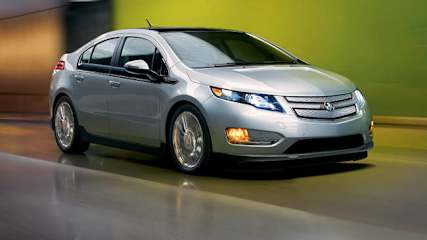
Holden Volt here within year
Read the article
By Paul Pottinger · 09 Dec 2011
An electric Holden that costs a “cup of coffee” to recharge will be on Australian roads in time for Christmas 2012.
The Volt, made by Chevrolet and to be sold here as a Holden, uses an electric motor that can be charged from home mains with a small back-up petrol engine. This both recharges the battery as you drive and extends the car’s range to about 500km before refuelling or re-charging.
Holden Chairman and Managing Director Mike Devereux said the Volt could travel for up to 80km of electric driving on its lithium-ion battery alone, which could then be re-charged in “four hours for about $2.50”.
“That’s the price of a cup of coffee,” he said. “Though maybe not in Sydney.”
The Volt can be recharged at a standard household power point. If an outlet isn’t to be found, it can be refuelled with petrol.
“Volt is the no compromise electric car. It’s electric when you want it and petrol when you need it,” Mr Devereux said.
“It carries four people and their luggage. Volt will make driving more economical, more environmentally-friendly and will fundamentally change the way Australia thinks about alternative transport solutions. This is the sort of innovation that people don’t necessarily associate with Holden.”
There is no word yet on pricing, though in the United States where the Volt has won the prestigious Motor Trend 2011 car of the year award, it is priced at about A$40,500.
The Volt’s most notable client is talk show host Jay Leno. Though owner of some 200 prestige cars, his daily drive is the Volt in which he recently joined the 10,000 Mile (16,000km) Club, owners who have travelled that distance in electric cars.
But the safety of electric cars was questioned last month when a Volt that had been crashed tested by safety officials, burst into flames some three weeks later. General Motors CEO Dan Akerson to buy back the car from any owner who is afraid it will catch fire.
Devereux stood by the car’s safety record and said a possible solution to any such problem is to discharge the lithium-ion battery after a collision.
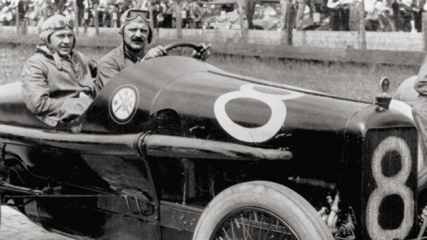
Chevrolet turns 100
Read the article
By Chris Riley · 17 Nov 2011
Chevrolet was founded in Detroit, in November 1911, by racer Louis Chevrolet and General Motors founder William C. Billy Durant, who developed cars that quickly earned reputations for performance, durability and value. Those traits remain at the core of Chevrolet, which is the world's fourth-largest automotive brand.
From the very start, Chevrolet brought technology and features typically reserved for more expensive cars to its lineup of affordable cars and trucks. The first Chevrolet — the Series C Classic Six, offered an electric starter and electric headlamps at a time when both were rarities among even luxury cars.
In the decades that followed, innovations such as safety glass, fuel injection, anti-lock brakes and electronic stability control systems were used on Chevrolet models at the same time as more expensive vehicles.
As one of the largest-selling brands in the industry, Chevrolet's early adoption of landmark technologies fundamentally changed the way they were applied to new vehicles.
Chevrolet also made performance affordable. Its early four and six-cylinder engines were known for durability and strong performance, but it was the 1955 introduction of Chevrolet's small-block V8 that began a new era in attainable high-performance.
The engine would power millions of cars and trucks in next 50 years, with its legacy passed on to a new generation of small-block V8s used in today's trucks and SUVs, as well as performance cars including the Camaro SS and Corvette.
The performance characteristics of the small-block V8 helped establish Chevrolet as a force in almost all forms of motorsports. Chevrolet-powered race cars were immediate contenders in the fledging stock car and drag racing worlds of the 1950s, growing to dominate them in the next decades.
Design has been a cornerstone of Chevrolet and its models have become icons of American culture. The soaring fins of the 1957 Chevy Bel Air epitomized the optimism of the Jet Age, while the sleek 1963 Corvette Sting Ray is regarded by many automotive historians as one of the best-looking cars ever designed.
Other Chevrolet models' designs had cultural impacts that resonated for decades. The Camaro, introduced in 1967, brought great design and affordable performance to younger customers. The heritage-inspired design of the fifth-generation model, introduced for 2010, became the best seller among its primary competitors.
In the truck world, Chevrolet design innovations helped drive changes and create new markets in the industry. The Suburban was introduced in 1935 and continues as the longest-running automotive nameplate in industry history. Its concept of delivering greater passenger and cargo capacity has remained true for 76 years.
In 1955, the special-edition Chevrolet Cameo Carrier introduced smooth rear fenders for the first time to a mainstream pickup. The styling gave the truck a flowing, upscale appearance that differed greatly from the traditional step side design of other contemporary trucks.
Within a few years, the entire industry was transformed. The smooth cargo bed sides, which became known as fleetside styling, were found on every truck on the market.
The electrically driven Volt leads Chevrolet into its second century and redefines what a car means. It is the world's first mass-produced electric vehicle with extended range, providing up to 500km of driving.
That means Volt provides the benefits of an electric vehicle without the range limitations associated with other electric vehicles in the market expanding the boundaries of performance and efficiency.
It exemplifies Chevrolet's heritage of introducing advanced technology on value-driven products.




